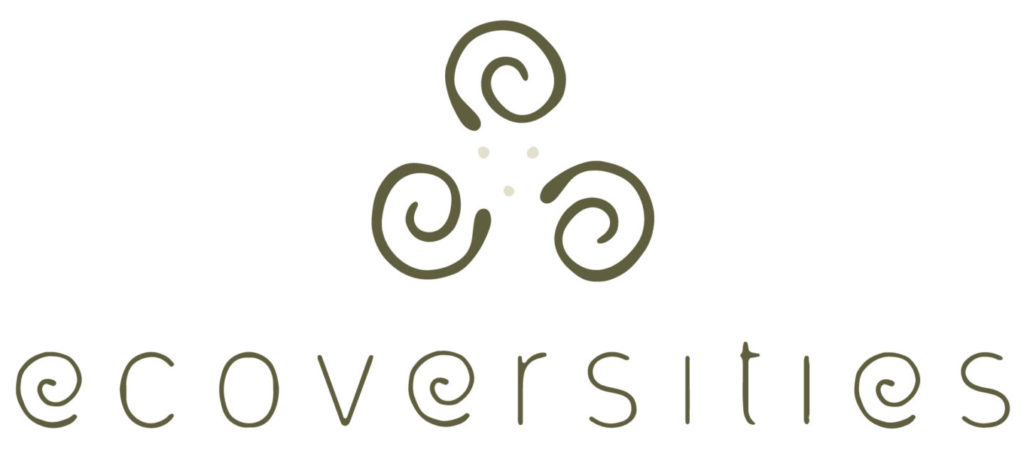By: Francisco Morejón
Dear Ecoversities friends,
It is with great excitement that I sit down to write and document my process. Below you will find details of my experience, my journey, and my thinking-feelings. I want to express my gratitude to the Committee who granted the funds for this journey to take place. I deposit my love and trust to this alliance, and hope I can continue to be of service as a weaver.
I chose written text because the sum total of my experiences are fresh in my mind, and I believe that my previous experiences have one way or another formed my mind to enjoy the action of sitting down and reflecting upon the lived experiences. For this reason I can come back to my own practice and share with the community thoughts, feelings, and practices that can help grasp my own experience of the residency program.
The country I traveled was Mexico, the ecoversity visited was Universidad del Medio Ambiente (UMA), the ecoversity friend hosting me, the one and only Victoria Haro.
Week 1 – Arrival and Welcoming
I arrived at the Aeropuerto Internacional Benito Juárez de la Ciudad de México, at around 2PM, had lunch, and started my journey to Valle de Bravo to meet Victoria. As soon as I stepped outside the reality of the new country and new experience began to be transformed into the loving energy Mexican people carry with them. Smiling, haciendo su chamba, doing their job, embracing the other. In about 40 minutes the perspective changed, the urban fabric started to show itself more clearly, the cracks on the concrete, the food on the streets, the cars and their speeds. I arrived to Terminal Poniente, where I was able to ask a street vendor for a phone call and contact Victoria, tell her I will be arriving two hours from then.
Traveling can be tiring, and my previous days before Mexico were also of traveling to a education conference in Ayampe, coast of Ecuador. So I fell asleep on the bus. So I was leaving the concrete jungle of the City of Mexico, to the marvel of my eyes
opening, I saw mountains, I saw green and orange colours meeting in the horizon
provoking a purple mixture. I smiled, my experience was not only going to be the city, but it was going to be close to nature. Minutes later I was stepping down on the bus station, and it was already surreal, it felt like stepping into an old colonial spanish city.
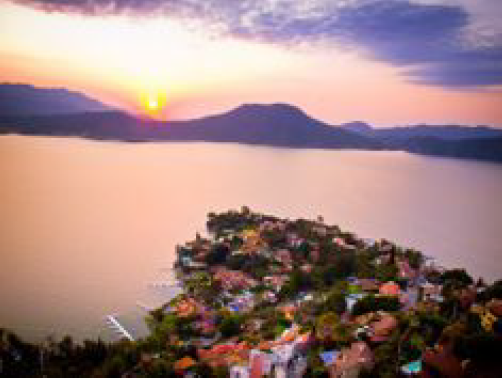
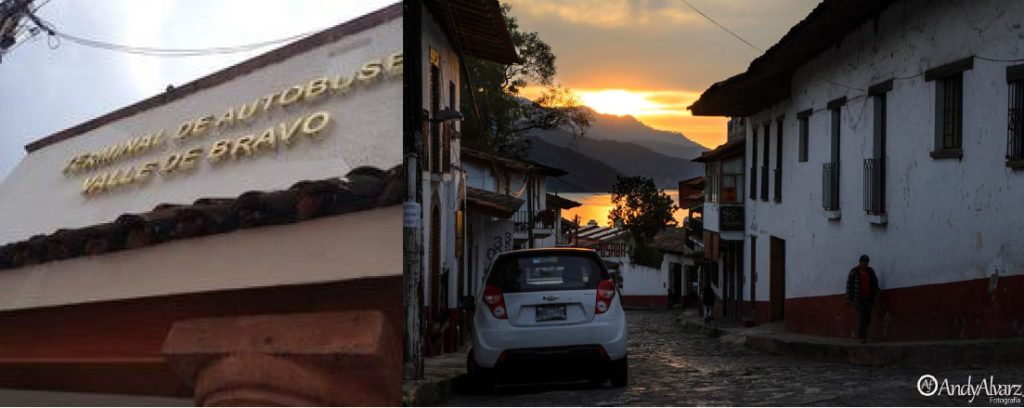
Victoria picked me up on her car, and I immediately felt again her energy, it is contagious, just by being next to her you start to have more energy too! Platicamos (we conversed), and she drove inside the city so that I could start to have a glance of the city! We arrived at her house, and a tour of the place started. My new room and bed for the upcoming weeks, a splace, a space and a place deeply entangled with nature. We bonded at night, shared drinks and delicious food, and the weight of travel invited for an early rest.
The next day we woke up to the smell of black tortillas, and cooked blue mushrooms unique to Valle de Bravo. In short time, we had to galop to UMA as there was a general meeting, or meetings 360 where they all catch up with their developments in the past few weeks. Thereafter, Vic presented me to Guillermo who is a student enrolled in the Sustainable Architecture Masters at UMA. It was an appropriate curation, for having an spatially aware student to explain the inner workings of the infrastructure was to my learning advantage.
Thereafter, the purpose of the visit was to cross-pollinate with UMA, QILAS, Victorian and I. The best way of getting a better picture of the project is though interviews, and so the rest of the days, I started to dive into the processes and the people at UMA. I was looking firstly to understand the University, and the education model. To do this I had an interview with Juan David and Victoria Sanchez, this was an interesting interview, they both were studying the Masters in Agroecologia.
Week 2 – Flow and the art of curating space and souls
The last day of the Unidad Temática Theme Unit, I was invited by many UMA students to spend time with them in the City of Mexico, to exchange ideas, and get to know their projects. The flow came with sensing the emergence, there was new information coming at me at a very high speed, and I did not want to let important connections pass. So I sensed the energy, there was a particular students who was showing a lot of interest. So I decided to allow for my intuition and flow to guide. I understand the power of changing geographical space, as an opporutnity to grow and learn. And what a better opporutnity to do it, with local people in Mexico City, who not only knew the city, but where there to help me understand it better, and also to weave our thoughts, ideas, and philosophies of education. I honored the opportunity and accepted to travel with him from Valle at the end of the UT1 to his place in the City of Mexico.
I have shared previously that the Theory of the Dérive was an important part of my research. Guy Debord was very clever in designing this theory, in his own words,
“A rough experimentation toward a new mode of behavior has already been made with what we have termed the dérive: the practice of a passional journey out of the ordinary through a rapid changing of ambiences, as well as a means of psychogeographical study and of situationist psychology. But the application of this striving for playful creativity must be extended to all known forms of human relationships, so as to influence, for example, the historical evolution of sentiments like friendship and love. Everything leads us to believe that the essential elements of our research lie in our hypothesis of the construction of situations” (Debord, 1957, p. 14).
During the next day, I took the morning off to honor (construct) the badge system of self-directed learning students use during their 3rd trimester at UMA. The reality is that as an educational enthusiast with a project of my own, many of the processes of self-directed learning happen organically, as I have to deal with the reality of implementing ideas existent in my mind that have not yet materialized in the world. I designed a badge for my learning, you can see it in the Picture below.
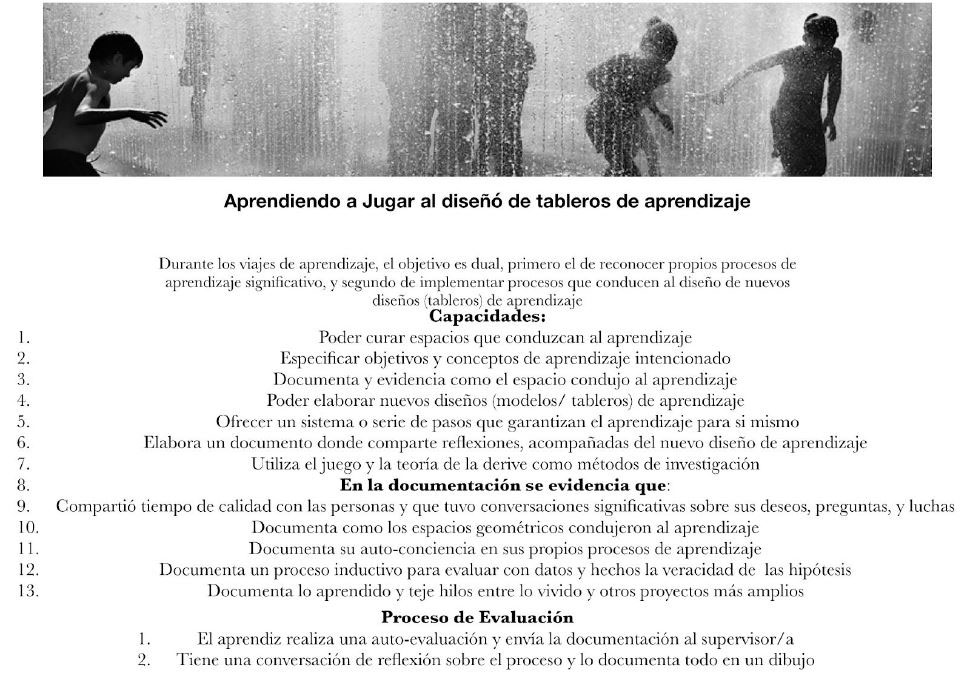
In translation the title says, learning how to play the game of designing learning boards. The reason this came about was thanks to most of the previous conversations I had in Mexico. The arrival to UMA and Mexico stimulated ideas that I hope could eventually translate in the implementation of many “learning boards” at QILAS. More specifically, the first time I started to think about it, was during our first deep bonding session with Victoria sitting in a couch in her house next to her office. We spend at least three hours sharing ideas about our projects, and it was helpful to have her experience re-organize my mind, as this is not a common experience in Quito. Vic is a mentor, so she is able to ask questions that I am not aware they exist, thus, allowing for a very powerful form of self-awareness and deep reflection upon myself and QILAS. I had been reading about the construction of Situations, of the Situationist International. They were exploring the psychogeography of places, combining their Theory of the Dèrive with the psychogeography of the city. This led to the understanding that humans have certain type of Geometries of Habit. What this entails is that we behave according to certain patterns, and those patterns have certain type of geometries that are repeated in order for us to function in the real world. This idea was a guiding framework throughout my learning journey and brought about many opportunities.
When I proposed this idea to Victoria, our conversation scaled to the point where I was able to realize that what would be great as a design of learning at QILAS would be to have multiple methods of learning, and multiple content. This means, that for the former you can choose from Problem Based Learning, to Project Based Learning, or Story-telling or learning journeys all as a way of instruction at QILAS. You can explore the ones you like, and use them as you see fit. For the latter, you are encouraged to take courses in the Liberal Arts, that is, Humanities, Social Sciences, Natural Sciences, and the Arts. So you get a wide range of options to learn at QILAS, and idea that I am looking forward to exploring now coming back to the institution after the Residency. I was only able to visualize this insight through conversing with Victoria.
Therefore, the badge represents two things. The first one, was to honor the learning method of self-directed learning applied in UMA, by applying it to my own journey in Mexico. The second one, is an idea that I hope becomes more clear as QILAS grows, and it is the idea that in the future I hope students are able to go out in the world with methods of learning to learn about it, and also being able to design their own frameworks to learn anything, an exercise that comes with self awareness.
So, when I was invited by Carlos Chiver to come to Mexico I was first reluctant, but I could sense his enthusiasm and energy, and thought I should respect it by flowing with it. In no time after his invitation, many other students started to invite to spend time with them in Mexico City, and I thought this was a sign that I should continue my learning Journey in the City. I spoke with Vic, and had a feeling that going there would be a good opportunity to learn. I had my badge in mind, my theory on geometries of learning, the influence of a space (City) as a site of psychogeographical space conducive to learning. So I accepted, and went with him to see what this new opportunity of flow, and trust in my intuition of following the energy of souls would teach me. Before leaving, Vic made some remarks in the form of advice. First she spoke of Trajan, who in the design of his learning journey at UMA prioritized people over places. This meant that spending time with the right people, was set as a priority than spending time getting to know places. Thereafter, Vic told me that I should sense what are my priorities and those of QILAS.
My case is a bit different, with the bias of Karim as another of my mentors, I have learned the importance of space, and there was no better combination than uniting space and people for the curation and co-design of my learning journey, more specifically in Mexico City. Having more time than Trajan, I was able to flow with the souls who invited me to Mexico, and while they knew the city pretty well, they were also education enthusiasts with projects of their own. So not only would I have a curation of the city by locals, but also will have the chance to bounce ideas with them, and collect relevant feedback for Vic and UMA.
Here the magic started to happen, I have trusted my intuition, and at a short age I would like to say that it has served me well. And it did, with Carlos after having some time to reflect upon my badge on playing to the design of learning frameworks, I was curious to test my ideas. So now with his companionship, we started to become very aware of spaces as conducive to learning. To my good fortune, Carlos is an architect, so he was also very specially aware when we went out a la Dérive in Mexico City. It was good to bounce ideas with him, and here is where I came to realize that a triangular structure with three people sitting close to each other, plus the intention of learning, was a very good geometry which is conducive to learning. Also realized that spending time at floor level for instance has the potential to offer closer educative and humane connection than being at a table level. It is more intimate, and thus also conducive to learning, so here it was another theory being to the test. I asked Carlos if he knew of a Tea House in City, and once we arrived, we chose to sit at floor level, which proved to be a really good idea to honor a conducive flow of conversation about our lives, past experiences, and learning intentions. The next day was also an interesting one. We had the opportunity to use the morning to go and meet the school he has founded for children near his place, Polanco. To all the surprise even though being part of the elite, and highly rooted in a Montessori model of education, it seems that they (his sister and himself) were really good at defining their conventional Jewish community educational traditions. In terms of learning, this was highly special and particular, somehow, I was already brewing in my head a new model of learning. My mind given the badge was also predisposed to a certain orientation, as my goal was effectively to draw the model of learning I was currently engaging with. It turned out to be theoretical, but the process was vital for its discovery. the path demonstrated the intuition. Once I had written the badge, I was in my mind trying to come up with a way of “inventing”, of codifying, the way I was currently learning. Thus, what I figure was that I had to continue with the flow of event , and eventually try to put it all in the model.
I went with Carlos and his sister to the school, Merkaz , which is a Jewish initiative that incorporates sustainability, Montessori, and Judaism as the core of their philosophy of education. The main place of site, where I started to develop my own “learning board” was when I came to spend some time with Carlos. I was really curious to explore the geometries of learning, and to this point I had come to discover that a triangular figure was more conducive to learning. Carlos mentioned Steven Johnson, who is the author of Emergence: The connected Lives of Ants, Brains, Cities, and Software , where he explains the concept of emergence and the connection to the spatial context. For instance he discusses, the relevance of New York city as an architectural and urban design that is conducive and vital to the exchange of information and learning, due to its long streets, cafes, and co-working spaces. With this in mind, I thought, perhaps this can be brought down to the personal level, the face to face interaction. There could be geometries that are more conducive to learning. We are used to sitting in front of each other, but from a body language perspective, this to some extent, is somewhat threatening or challenging. Circles are much better for proximity, but the world is not designed in circles, it is designed in squares. So I chose not to sit in front of you, but rather next to you, and this seemed to me a more closer and intimate way of relating to someone else. Once in Merkaz, I have introduced the idea of geometries of learning to Carlos and Sherry his sister. I also mentioned that I was working on the design of a new learning model, and so I also was conscious now of the concept of emergence. Emergence is conceived as a powerful combination of influences and relationships of each participant so the whole is greater than the sum of the parts. This is to say, that emergence happens with two more persons, and they are actively contributing to the generation of whole that is greater than the sum of its parts. In this sense emergence requires the cooperation of a set of people who intentionally are seeking for a new outcome.
“Therefore Johnson illustrates five fundamental principles for building bottom-up systems:
More is different : A critical mass of ants is necessary for useful statistical averages to emerge. One or two ants bumping against each other is not a colony.
Ignorance is Useful : Simplicity of the individual components (i.e.: the ants) is beneficial. There is no need for each ant to have imprinted a map of what is in the colony’s best interests, and in fact such ideas would be a disadvantage to the colony as a whole.
Encourage random encounters : The author exemplifies how ants use the feedback from encountering the activities of other ants to usefully modify their behaviour. Analogical in “The Death and Life of Great American Cities” by Jane Jacobs shows how humans in urban areas positively affect the emergence of cities by their encounters in public areas.
Look for Patterns in the Signs: Ants follow trails of pheromones left by other ants. In the research field it is common that you study a significant number of papers and emerge these thoughts to a newer and bigger one.
Pay Attention to Your Neighbours: “Local information leads to global wisdom.” When an ant notices a large number of his fellow ants are foraging, he will alter his behaviour to another activity. Likewise, in the development of a human embryo, individual cells are able to get information from their neighbours that will guide them in their own formation, whether that be as skin cells, bone cells, muscle cells…” (p.2, n.d).
In this spirit, I wanted to honor the moment with Carlos and his sister, it was a random encounter, they had new information as they were working with Montessori to a depth that I have not engaged with before. And thus, spontaneously, we were standing in a triangle conversing about these thoughts. Suddenly, the emergence started to take place, we entered a new realm, that one of creation, asking questions, looking for answers, assuming our ignorance. My mind was trying to use my previous knowledge about education to look for a new connection. After minutes of intense interrogation to each other, agreement and disagreement suddenly I felt the food was cooked. It might seem like a very simple, boring, and theoretical model, but there is something in it which I like. See model below.

What this model is trying to show, is that in the process of developing something new, in my own bias and perspective. This was a useful process, perhaps it can also help others as a model. So there is always a material reality from which we all began our thought processes. Then through conceptual thinking, we move towards the infinite, the world of consciousness that is bounded by our own creativity and desire of infinity. When arrived here through conversation with a group of people with an intention, emergence takes places, something beings to brew, and then an open and flexible mindset and a predisposition to create something new must be in place, otherwise people fall back into their previous beliefs and remain static rather than dynamic. The final, step is that just envisioning that something new, is not enough, it must be brought back to material reality, as a drawing or something physical, otherwise it can be lost in the infinity of consciousness. This is what I was able to see, during this journey at Merkaz with Carlos. To this point, I was thankful to Vic, who insisted on sitting down and designing a badge for my learning journey. Now I wanted to share it with people, and keep playing with the geometries of learning.
Following my intuition about energy, I had the chance to meet Vanessa during the first week of class at UMA. She had invited me to a Temazcal, which was a beautiful and transformative experience. I think that part exactly of the process of learning is allowing for the moments, and the construction of situations to take place. In this case the Temazcal, also opened many doors to my own self-knowledge and a practice that was thus, also proposed for the Ecoversities Regional Gathering this year as well.
I spent some time with Vanessa, and she too was speaking about geometries of learning in the context of system dynamics and systems thinking. We had the opportunity to speak for hours, and this showed us that there was a lot of potential for collaboration. With her I had the chance of learning about stock and flows in systems thinking, and it was an energy that I knew I had to keep close. During that night I invited her to the Ecoversities Regional gathering, and she bought the ticket the next week to come and share all her knowledge about modeling, and
geometries, and agreement fields in collective systems.
To this end, I had already also collected a lot of valuable information about UMA, and how to offer some improvements and feedback.
Week 3 – Global Vibe
Nic arrived on Thursday around noon, this was our beginning back to Valle de Bravo. Nic Martino is the person who design the Change Maker Curriculum at Think Global School. A high school that travels around the world using project based learning as their main method of instruction. We had the opportunity to spend a lot of time speaking about how to change global education through local initiatives. About the importance of self care as leaders of projects, and he told me about the his episode in Botswana where he got diabetes at the age of 33 after eating super carbs, common food in Botswana. After another period of teaching in India he had to leave the school to take care of his health. It was very special to arrive back to Valle de Bravo with Nic. The next day we had the chance to go for a long walk and spend time with Silvia, the mother of one of Nic´s students, and also the best friend of Vic. She spoke about different projects like Dragon Dreaming, and Kaospilots. Thereafter we went to visit two projects started by Silvia, one for small kids where they can come and play. The other was a permaculture project called Flor y Canto.
We had some pulque and together with Vic, Nic, Silvia and her brother we meditated and philosophized about education for the next 4 hours. Lots of learning occurred, and it was evident that the type of connections that we were engaging in were extremely profound. That same night, we went to an event where for 2 hours or so and friend of Carlos Hagerman Juan José read poetry to everyone in a pub.
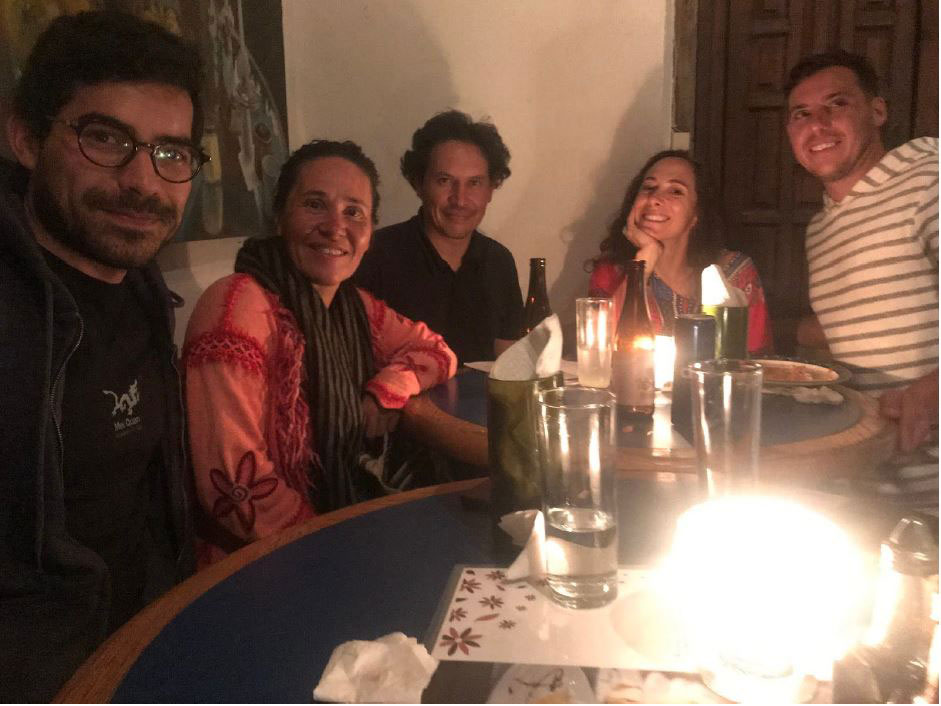
The next day we had the chance with Nic to go out for lunch, and in the conversation and sharing we realized that there are many opportunities for connection and sharing. We started to think about a initiative he has been working with, like a type of global mentorship programmes for youngsters, with a mixture of an online global platform of education in the liberal arts. We got very excited about such a project, and we are now working towards its construction.
Week 4 – Weave and Embrace the new beginning
During the fourth week, it seemed that time was now going backwards, it was a countdown to coming back to Ecuador, and that meant that the preparations for the regional gathering where on point. An important point took place here, and it was that Vanessa had come for a workshop at UMA, and that same night we had an skype session to design part of the gathering with Marco, ecuadorian friend who was helping the co-hosting of the gathering. Vic joined this conversation as it was a matter of destiny, and she was able to share her experience about ecoversities and it history. We used that information to also have in mind the steps and processes that we should include during the gathering. In the upcoming days, the work turned towards trying to document, or record the process of the 3 previous intense weeks of learning. I was able to give feedback to Vic about all the sorts of information I gathered by interviewing UMA students in Mexico City and during my previous conversations with them at the UMA campus. In this sense we were able to make sure that there was pollination and growth from my visit between UMA and QILAS. It was a great opportunity for me to grow and learn more than ever before. To end the week, we had some more zoom sessions with Gerardo, Carmen, Marco, and Vanessa to work out the design of the gathering which was coming up the week after this. The type of ideas that I encountered in Mexico come with me, very close to my heart. It gave me energy and prepared me to keep growing and keep giving my life to education, to QILAS, to Ecoversities.
